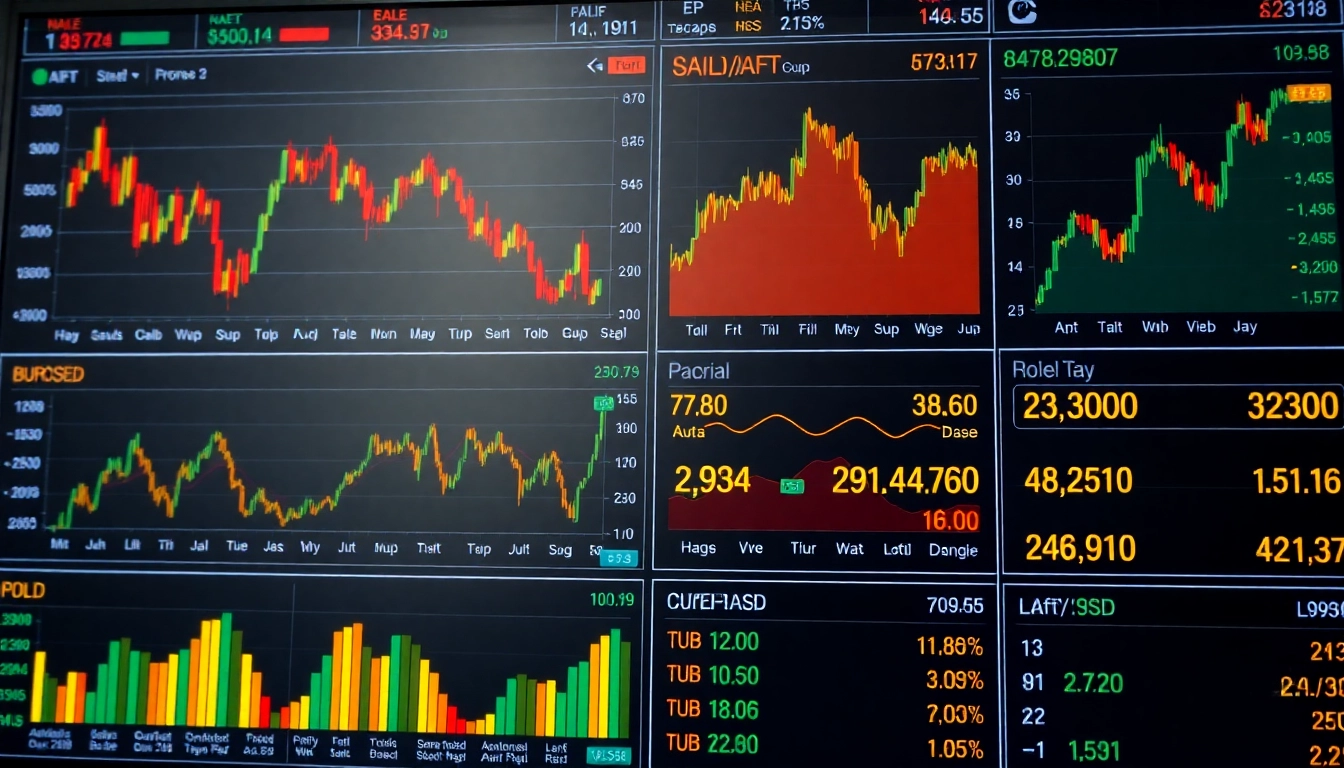Understanding the Latest UK Trading Updates and Market Trends
In the dynamic world of finance, staying informed about recent market movements is crucial for traders and investors alike. The latest UK Trading Updates reveal a landscape characterized by mixed stock performances, record-breaking precious metals, and fluctuating currencies. These indicators not only reflect current economic sentiments but also serve as vital inputs for shaping strategic investment decisions. This article delves into recent market performances, global influences, and practical insights to help you navigate the complexities of the UK’s financial ecosystem effectively.
Overview of Recent Market Performance and Key Economic Indicators
Stock Markets: Mixed Signals Amid External Shocks
Recent UK stock market activity illustrates a cautious yet resilient environment. The FTSE 100 and European indices closed marginally higher, supported by specific sectors such as defense and banking, despite broader global uncertainties. For example, the pan-European STOXX 600 increased by 0.17% to 551.07, reflecting modest investor confidence. Contributing factors include the ongoing geopolitical tensions, inflationary pressures, and central bank policies.
Moreover, the U.S. market’s downward trend, attributed to concerns over fiscal policies such as potential rate cuts and geopolitical conflicts, influences UK trading sentiments. The divergence between the U.S. and European markets underscores the importance of understanding regional economic indicators and their impact on UK assets.
Commodity and Currency Movements: Gold Hits New Highs
Gold prices surged past $3,500 per ounce, with a record high of $3,501.59, driven by inflation concerns and geopolitical stability fears. This surge signals a flight-to-safety among investors amid market volatility and currency fluctuations. Similarly, the movement of currencies such as the Euro and Yen reflects geopolitical and economic shifts, with the dollar slightly weakening ahead of key U.S. labor data release.
For traders, recognizing these signals is vital for hedging and portfolio diversification, especially given the correlation between gold prices and inflation expectations.
Impact of Global Events on UK Trading Activities
Geopolitical Tensions and Market Volatility
Global geopolitical developments, such as US-China trade tensions, the potential release of cryptocurrencies like Libra, and policies from major economies, exert significant influence on UK markets. For instance, statements from US advisers or Federal Reserve signals can trigger fluctuations across asset classes, including equities, forex, and commodities.
Additionally, regulations and political developments in China, particularly concerning trade and commodities like iron ore and oil, directly impact the UK’s import-export dynamics. For example, weak Chinese industrial data has led to a decline in iron ore futures, affecting mining stocks and related sectors in the UK.
Global Monetary Policies and Currency Fluctuations
Recent hints of U.S. rate cuts and perceived dovish stances by the Federal Reserve have led to a decline in the dollar, impacting GBP/USD exchange rates. Similarly, the Bank of England’s cautious stance on monetary easing influences interest rate expectations and sterling valuations.
Investors should monitor these policy signals, as shifts can swiftly alter the risk landscape, creating both opportunities and challenges.
Strategies for Navigating Stock Markets Amid Mixed Signals
Opportunities in Volatility
Market volatility, while challenging, also presents unique opportunities. Investors leveraging technical analysis can identify entry points during dips or consolidation phases. For instance, assets resilient to macroeconomic shocks, like certain banking or defense stocks, may offer safe havens.
Another approach involves sector rotation—shifting investments towards sectors likely to outperform under current conditions, such as commodities and traditional safe havens amidst inflation concerns.
Effective Risk Management Tips
Recent UK trading updates emphasize the importance of robust risk mitigation. Techniques such as setting stop-loss orders, diversifying across asset classes, and monitoring key economic indicators can minimize downside risks. For example, using real-time economic data to adjust holdings can safeguard portfolios during sudden market swings.
Moreover, employing hedging instruments like options on gold or currency forwards can protect against adverse movements and balance the portfolio’s risk profile.
Case Study: Adaptive Investment During Market Fluctuations
Consider a UK-based institutional investor who alternated between equity securities in resilient sectors and gold, aligning with real-time market signals. During a period of geopolitical uncertainty, reallocating assets into precious metals and defensive stocks helped preserve capital, as evidenced by overall portfolio stability compared to benchmarks.
Gold and Currency Markets: Tracking Record Highs and Dollar Fluctuations
Drivers of Gold’s Record Highs
Gold’s rally past $3,500 is primarily driven by inflation fears, geopolitical instability, and a weakening dollar. Investors seek safe-haven assets amidst uncertain economic prospects, and with US inflation data in focus, gold becomes a vital hedge.
Furthermore, central banks globally have increased gold reserves, emphasizing its role as a hedge against monetary easing. These dynamics suggest that gold remains a strategic component in diversified portfolios.
Currency Dynamics and Implications
The GBP/USD exchange rate has experienced fluctuations influenced by UK economic data and US monetary policy signals. A softer dollar tends to bolster investment in UK assets; however, uncertainty in US rate adjustments can cause jitters. The euro’s recent rally aligns with the European Central Bank’s cautious stance on tightening policies.
Investors should consider currency-hedging strategies or diversify into non-USD assets to mitigate forex risks.
Incorporating UK Trading Updates into Your Investment Planning
Tools and Resources for Real-Time Market Data
Traders can utilize advanced tools like market analytics platforms, economic calendars, and news feeds to stay ahead. Real-time updates on UK trading, available through specialized services, enable timely decision-making and risk assessments.
For example, integrating data feeds into trading algorithms enhances responsiveness to market shifts, as witnessed in recent successful tactical adjustments.
Building a Diversified Portfolio Based on Current Insights
Diversification remains a cornerstone principle. Combining equities across sectors, commodities like gold, and currency positions aligned with macro trends minimizes exposure to any single risk factor.
Given the current market environment, a balanced mix of safe-haven assets and opportunistic sectors can align with long-term goals while accommodating short-term volatility.
Monitoring and Dynamic Adjustment Strategies
As new UK trading updates and global data emerge, proactive portfolio rebalancing is essential. Objective triggers, such as economic indicator thresholds, can automate response strategies, ensuring portfolios adapt seamlessly to evolving conditions.
Future Outlook: How UK Trading Updates Shape Long-Term Investment Goals
Forecasting Methods Based on Market Updates
Advanced analytical tools, including machine learning algorithms and scenario analysis, enable investors to interpret complex data patterns. Incorporating regular UK market updates improves forecasting accuracy for asset performance and risk exposure.
For active investors, maintaining flexible models that incorporate real-time updates ensures staying aligned with projected market cycles.
Geopolitical and Economic Factors in Long-Term Trends
Geopolitical stability, trade agreements, and monetary policy directions fundamentally influence long-term strategies. For example, UK’s evolving relationship with the EU and US impacts trade flows, currency stability, and sectors like financial services and manufacturing.
Strategic planning must factor in such variables, with scenario analyses helping anticipate possible outcomes and prepare contingency plans.
Preparing for Future Market Cycles
Using data-driven insights, investors can develop phased investment approaches, gradually increasing exposure during bullish periods and reducing risk in downturns. Continuous monitoring of UK trading updates provides the vital intelligence needed to adjust these cycles effectively.



